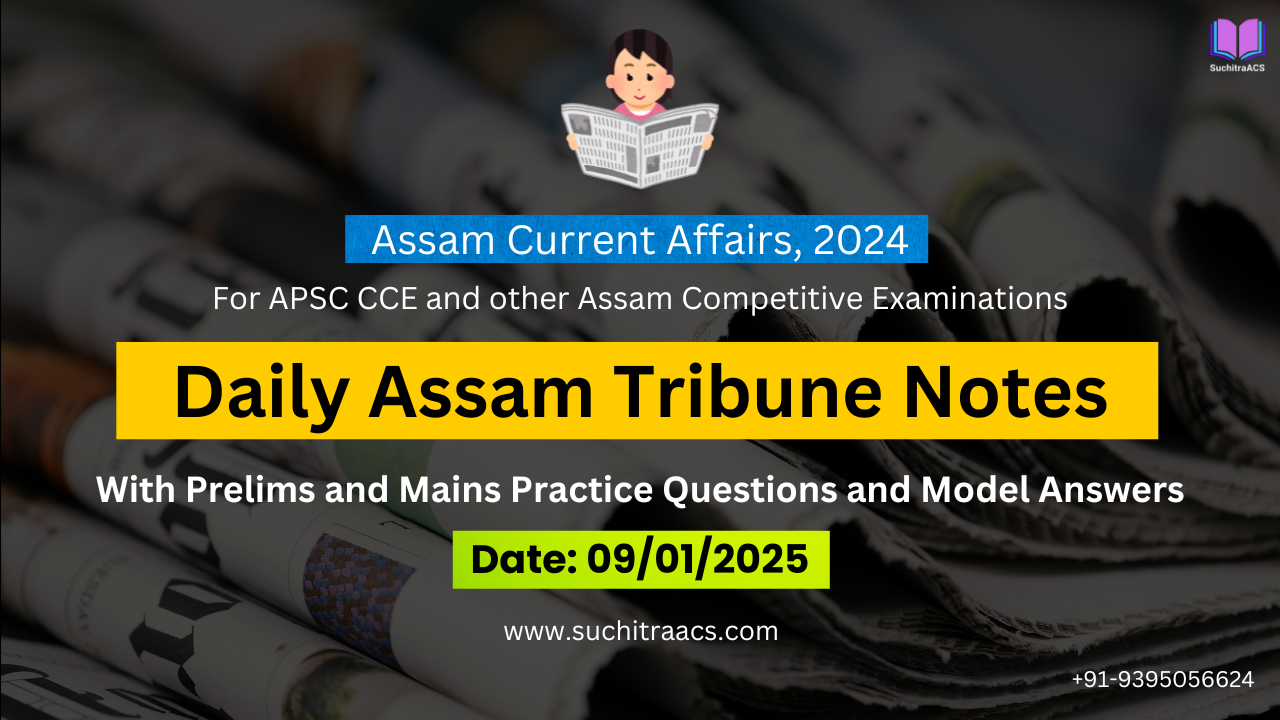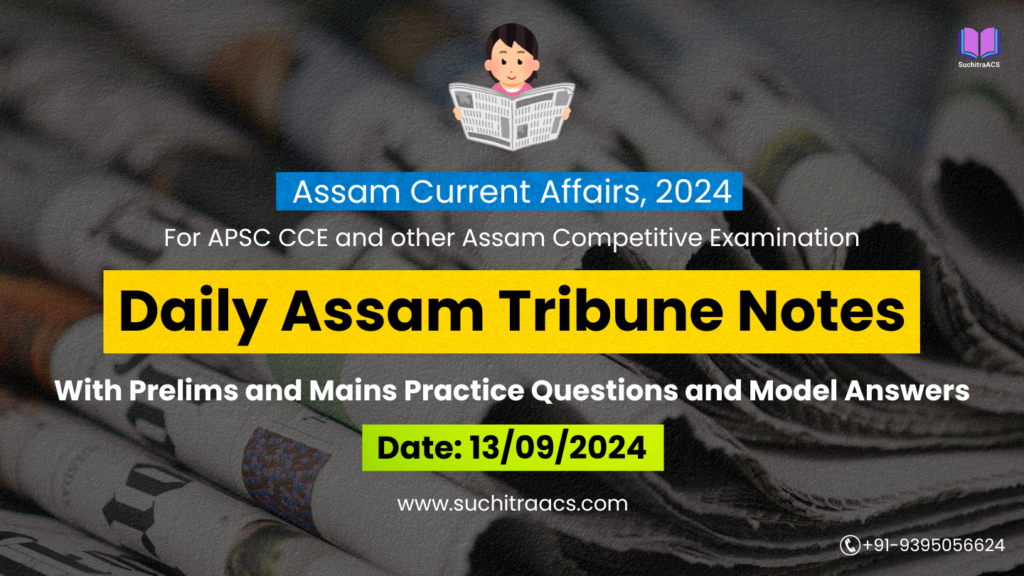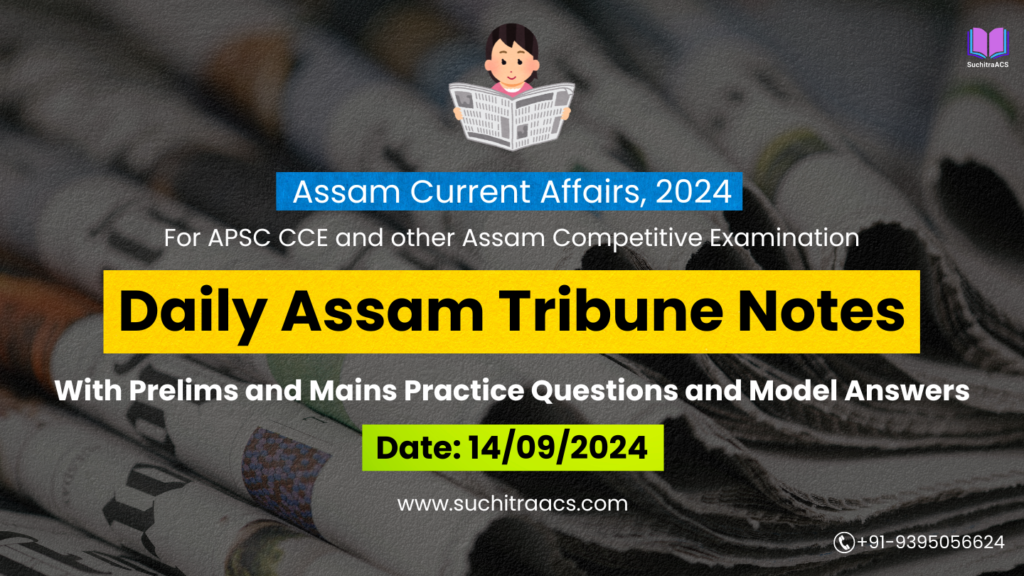APSC Current Affairs: Assam Tribune Notes with MCQs and Answer Writing (09/01/2025)
For APSC CCE and other Assam Competitive examinations aspirants, staying updated with current affairs is vital. This blog covers most important topics from the Assam Tribune today (09-01-2025). These issues are key for both APSC Prelims and Mains preparation, offering insights into the APSC CCE Syllabus.
1. Brahmaputra Basin Biodiversity Conservation Initiative
GS Paper 3: Environment and Biodiversity
Introduction
The Ministry of Environment, Forest, and Climate Change (MoEFCC), in collaboration with Assam and Arunachal Pradesh governments, launched the Brahmaputra Basin Biodiversity Conservation Initiative on January 9, 2025. This program aims to preserve the fragile ecosystem of the Brahmaputra River basin, a biodiversity hotspot critical for sustaining livelihoods and maintaining ecological balance.
Key Points
- Program Objectives:
- Protecting endemic species like the Gangetic dolphin and the golden mahseer.
- Restoring degraded wetlands and riparian forests along the Brahmaputra.
- Enhancing community participation in biodiversity conservation.
- Key Actions:
- Mapping sensitive biodiversity zones using satellite data and GIS technology.
- Establishing biodiversity parks and eco-restoration projects.
- Developing sustainable fishing and agroforestry practices to minimize ecological impact.
- Focus on Threatened Species:
- Gangetic Dolphin: Increasing dolphin reserves along the river.
- Golden Mahseer: Promoting captive breeding and release programs.
- Wetland Birds: Creating safe habitats for migratory birds in Kaziranga and Pobitora.
- Community Involvement:
- Training local communities in sustainable livelihoods such as eco-tourism.
- Incentives for adopting conservation-friendly practices.
Prelims Pointers
- Gangetic Dolphin: National aquatic animal of India, found in the Brahmaputra and Ganga rivers.
- Golden Mahseer: Freshwater fish critically endangered due to habitat destruction.
- Riparian Forests: Vegetation along riverbanks that stabilizes ecosystems and prevents soil erosion.
Mains Pointers
Significance of the Brahmaputra Basin Biodiversity Conservation Initiative:
- Ecological Importance:
- Maintains ecological balance by protecting endangered species and ecosystems.
- Contributes to climate resilience by restoring degraded wetlands.
- Economic Benefits:
- Boosts eco-tourism opportunities, generating income for local communities.
- Promotes sustainable fishing, ensuring long-term livelihood security.
- Addressing Environmental Challenges:
- Mitigates threats from deforestation, pollution, and unregulated fishing.
- Reduces the impact of climate change on riverine ecosystems.
Challenges in Implementation:
- Anthropogenic Pressures:
- Overfishing, industrial pollution, and unplanned urbanization.
- Coordination Issues:
- Effective collaboration between multiple stakeholders and states.
- Community Resistance:
- Resistance to changes in traditional fishing or agricultural practices.
Way Forward:
- Strengthen Research:
- Conduct regular biodiversity assessments to track conservation progress.
- Policy Integration:
- Align the initiative with national programs like the National Biodiversity Action Plan (NBAP).
- Community-Based Models:
- Involve local communities in eco-tourism and conservation activities to ensure sustainable outcomes.
- Cross-Border Cooperation:
- Collaborate with neighboring countries like Bhutan for basin-wide conservation.
Conclusion
The Brahmaputra Basin Biodiversity Conservation Initiative reflects India’s commitment to safeguarding its natural heritage. By integrating science, policy, and community participation, this program can ensure the long-term preservation of one of India’s most vital ecosystems.
2. Wildlife Corridors in Northeast India
GS Paper 3: Environment and Biodiversity
Introduction
The Ministry of Environment, Forest, and Climate Change (MoEFCC) launched a new project on January 9, 2025, to establish and restore wildlife corridors in Northeast India. The initiative focuses on connecting fragmented habitats, ensuring safe movement of wildlife, and mitigating human-wildlife conflicts in the region’s biodiversity hotspots.
Key Points
- Significance of Wildlife Corridors:
- Connect fragmented ecosystems, allowing species to migrate for food, mating, and shelter.
- Reduce habitat isolation caused by deforestation, infrastructure, and urbanization.
- Corridors Identified:
- Kaziranga-Karbi Anglong Corridor: Ensures the safe passage of elephants and tigers.
- Manas-Buxa Corridor: Facilitates tiger and rhino movement between Assam and West Bengal.
- Dihing Patkai Corridor: Protects the movement of clouded leopards and hornbills.
- Program Highlights:
- Habitat restoration through reforestation and removal of encroachments.
- Installation of eco-bridges and underpasses on highways.
- Community engagement to reduce human-wildlife conflicts.
- Funding and Support:
- ₹1,000 crore allocated under the National Wildlife Action Plan (2023-2030).
- Collaboration with NGOs and international conservation bodies like WWF.
Prelims Pointers
- Wildlife Corridor: A protected route connecting isolated habitats to facilitate wildlife movement.
- Kaziranga National Park: A UNESCO World Heritage Site, home to the largest population of one-horned rhinoceroses.
- Eco-Bridges: Structures built over highways to allow wildlife to cross safely.
Mains Pointers
Importance of Wildlife Corridors in Northeast India:
- Biodiversity Conservation:
- Protects endangered species like tigers, rhinos, and elephants.
- Maintains genetic diversity by enabling interbreeding between isolated populations.
- Ecosystem Stability:
- Ensures species migration and seasonal movements, critical for ecosystem functioning.
- Reducing Human-Wildlife Conflicts:
- Provides alternative routes for wildlife, minimizing crop damage and attacks on humans.
- Global Climate Goals:
- Supports habitat connectivity, aligning with global biodiversity conservation targets.
Challenges:
- Encroachments:
- Illegal settlements and agriculture in critical habitats hinder corridor development.
- Infrastructure Development:
- Highways and railways fragment habitats, increasing wildlife mortality.
- Community Resistance:
- Local communities often oppose relocation or habitat restoration projects.
Way Forward:
- Habitat Protection:
- Strengthen legal frameworks to prevent deforestation and encroachments.
- Infrastructure Planning:
- Ensure all highways and railways in critical habitats include eco-bridges and underpasses.
- Community Involvement:
- Provide compensation for crop damage and alternative livelihoods to affected communities.
- Scientific Monitoring:
- Use technology like GPS tracking and camera traps to study animal movement and corridor effectiveness.
Conclusion
The establishment of wildlife corridors in Northeast India is crucial for conserving its rich biodiversity and mitigating human-wildlife conflicts. Through scientific planning, community participation, and robust funding, these corridors can ensure the long-term survival of the region’s unique ecosystems while promoting harmony between humans and wildlife.
3. Digital Connectivity Boost in Northeast India
GS Paper 3: Infrastructure, Development, and Governance
Introduction
On January 9, 2025, the Ministry of Electronics and Information Technology (MeitY) announced a significant initiative to enhance digital connectivity in the Northeast. The program aims to bridge the digital divide, improve e-governance, and support the region’s socio-economic development by connecting rural and remote areas to high-speed internet.
Key Points
- Program Highlights:
- Expansion of BharatNet Phase-II to connect over 10,000 villages in the Northeast by 2026.
- Establishment of 150 Digital Villages offering e-learning, telemedicine, and e-commerce services.
- Deployment of high-speed internet in border areas to boost communication and security.
- Infrastructure Development:
- Laying 15,000 km of optical fiber cables (OFC).
- Introduction of satellite-based internet in extremely remote regions like Arunachal Pradesh and Mizoram.
- Economic and Social Benefits:
- Supports local businesses by enabling e-commerce and digital payments.
- Enhances education through digital classrooms and online resources.
- Improves healthcare access via telemedicine services in remote areas.
- Strategic Importance:
- Strengthens India’s border security by providing seamless communication in sensitive regions.
- Aligns with India’s Act East Policy by integrating the Northeast with global digital markets.
Prelims Pointers
- BharatNet: India’s flagship rural broadband initiative connecting gram panchayats to high-speed internet.
- Digital Village: A rural hub offering e-services like education, telemedicine, and banking through digital infrastructure.
- Satellite Internet: Technology enabling connectivity in remote areas where fiber optics are not feasible.
Mains Pointers
Significance of Digital Connectivity in the Northeast:
- Economic Growth:
- Promotes entrepreneurship and small businesses through access to online markets.
- Attracts investments in IT and allied sectors, creating employment opportunities.
- Social Empowerment:
- Improves education by providing digital learning tools and resources.
- Enhances healthcare through telemedicine and remote diagnostics.
- Governance Efficiency:
- Strengthens e-governance initiatives, ensuring transparency and quick service delivery.
- Facilitates direct benefit transfers (DBT) to remote beneficiaries.
- Security and Integration:
- Enhances border communication for security forces in remote locations.
- Promotes cultural and economic integration of the Northeast with the rest of India.
Challenges:
- Geographical Barriers:
- Difficult terrain increases the cost and time of laying optical fiber networks.
- Digital Literacy:
- Lack of awareness and skills among rural populations to use digital tools.
- Maintenance Issues:
- Harsh climatic conditions and natural disasters often disrupt connectivity.
Way Forward:
- Leverage Satellite Technology:
- Expand satellite internet services in areas with challenging terrains.
- Digital Literacy Campaigns:
- Conduct awareness and training programs to empower rural communities.
- Public-Private Partnerships (PPPs):
- Collaborate with private telecom operators to share infrastructure and expertise.
- Monitoring and Maintenance:
- Set up regional hubs to monitor and maintain digital infrastructure regularly.
Conclusion
Enhancing digital connectivity in the Northeast is vital for bridging the digital divide and ensuring inclusive development. By addressing infrastructural and social challenges, the initiative can unlock the region’s economic potential, empower communities, and strengthen national integration.
4. Greening of Greater Guwahati City
GS Paper 3: Environment and Infrastructure Development
Introduction
The Guwahati Social Forestry Division has announced its ambitious “Greening of Greater Guwahati City” initiative under the SOPD (State-Owned Priority Development) scheme. This project aims to enhance urban greenery, improve air quality, and promote biodiversity in the region.
Key Points
- Project Details:
- Focus: Creation and maintenance of urban plantations along institutional and rural roadsides.
- Target: 1,250 saplings to be planted in the first year, with continuous maintenance.
- Funding: Total project cost of ₹15.63 lakh, including taxes.
- Scope of Work:
- Institutional Planting: Involves greening institutional campuses with indigenous and ornamental species.
- Roadside Planting: Enhances the aesthetic and environmental value of major urban roads.
- Key Objectives:
- Increase green cover to combat urban heat islands.
- Reduce air pollution by increasing tree density.
- Promote biodiversity by planting native species.
- Implementation Strategy:
- Use of local nurseries to source saplings.
- Deployment of trained workers for planting and maintenance.
- Regular monitoring to ensure plant survival and growth.
Prelims Pointers
- SOPD: State-Owned Priority Development, a scheme to address critical development needs.
- Urban Heat Island Effect: Urban areas experience higher temperatures due to reduced greenery and increased human activities.
- Indigenous Species: Plants native to a region, essential for maintaining ecological balance.
Mains Pointers
Significance of Urban Green Projects:
- Environmental Benefits:
- Reduces urban temperatures through natural cooling.
- Improves air quality by absorbing pollutants like carbon dioxide.
- Enhances groundwater recharge through reduced surface runoff.
- Social Impact:
- Promotes mental well-being by providing green spaces for recreation.
- Encourages community participation in environmental conservation.
- Economic Value:
- Boosts eco-tourism potential by creating visually appealing urban landscapes.
- Reduces healthcare costs associated with pollution-related diseases.
Challenges:
- Urbanization Pressure:
- Limited space for planting in densely populated areas.
- Maintenance Issues:
- Lack of resources for regular care and protection of plants.
- Community Awareness:
- Insufficient public engagement in preserving urban greenery.
Way Forward:
- Integrated Urban Planning:
- Incorporate green belts and parks in city master plans.
- Public Awareness Campaigns:
- Educate citizens on the benefits of urban greenery and their role in maintaining it.
- Technological Interventions:
- Use GIS mapping to identify potential planting zones.
- Policy Support:
- Incentivize green projects through tax rebates and subsidies.
Conclusion
The “Greening of Greater Guwahati City” initiative represents a vital step toward creating a sustainable urban environment. By addressing challenges and promoting community involvement, this project has the potential to transform Guwahati into a model green city.
APSC Prelims Practice Questions
1. Brahmaputra Basin Biodiversity Conservation Initiative
Question 1: Which of the following species is an endemic species protected under the Brahmaputra Basin Biodiversity Conservation Initiative?
A. Gangetic Dolphin
B. Snow Leopard
C. Indian Pangolin
D. Olive Ridley Turtle
Answer: A. Gangetic Dolphin
Explanation:
The Gangetic Dolphin, India’s national aquatic animal, is endemic to the Ganga and Brahmaputra river systems. It is a flagship species for the Brahmaputra Basin Conservation Initiative.
Question 2: What is the primary purpose of riparian forests as highlighted in the Brahmaputra Basin Biodiversity Initiative?
A. Promoting tourism along the riverbanks.
B. Stabilizing river ecosystems and preventing soil erosion.
C. Establishing fish breeding centers.
D. Supporting commercial forestry operations.
Answer: B. Stabilizing river ecosystems and preventing soil erosion.
Explanation:
Riparian forests along the Brahmaputra play a crucial role in maintaining ecological balance by stabilizing soil, preventing erosion, and supporting biodiversity.
2. Wildlife Corridors in Northeast India
Question 3: Which of the following wildlife corridors connects Assam to West Bengal for tiger and rhino movement?
A. Kaziranga-Karbi Anglong Corridor
B. Manas-Buxa Corridor
C. Dihing Patkai Corridor
D. Balpakram-Khasi Hills Corridor
Answer: B. Manas-Buxa Corridor
Explanation:
The Manas-Buxa Corridor is significant for enabling the movement of tigers and rhinos between Assam and West Bengal, helping maintain genetic diversity.
Question 4: Eco-bridges are primarily constructed to:
A. Increase tourism in national parks.
B. Provide safe passage for wildlife over highways.
C. Improve connectivity in remote regions.
D. Facilitate the migration of fish in river ecosystems.
Answer: B. Provide safe passage for wildlife over highways.
Explanation:
Eco-bridges are structures designed to mitigate human-wildlife conflicts by allowing animals to cross highways safely.
3. Digital Connectivity Boost in Northeast India
Question 5: Which flagship program is responsible for expanding rural broadband connectivity in India, including the Northeast?
A. BharatNet
B. Digital India Mission
C. Startup India
D. National Optical Fibre Initiative
Answer: A. BharatNet
Explanation:
BharatNet is India’s rural broadband initiative, focusing on connecting gram panchayats with high-speed internet, including those in the Northeast.
Question 6: Satellite-based internet is crucial for Northeast India because:
- The region’s terrain makes optical fiber networks difficult to install.
- It is more cost-effective than terrestrial networks.
- It ensures communication during natural disasters.
Select the correct answer using the code below:
A. 1 and 2 only
B. 2 and 3 only
C. 1 and 3 only
D. 1, 2, and 3
Answer: C. 1 and 3 only
Explanation:
While satellite internet is essential for difficult terrains and disaster communication, it is generally more expensive than terrestrial networks.
4. Greening of Greater Guwahati City
Question 7: What is the main environmental objective of the “Greening of Greater Guwahati City” initiative?
A. Enhancing tourism in Guwahati.
B. Promoting urban forestry to combat heat islands.
C. Increasing agricultural productivity in peri-urban areas.
D. Creating eco-parks for biodiversity conservation.
Answer: B. Promoting urban forestry to combat heat islands.
Explanation:
The initiative focuses on increasing green cover to mitigate the urban heat island effect and improve air quality in Guwahati.
Question 8: The term “indigenous species” refers to:
A. Species introduced from other regions.
B. Species native to a particular region.
C. Species cultivated for commercial purposes.
D. Species protected under international treaties.
Answer: B. Species native to a particular region.
Explanation:
Indigenous species are native to a specific geographic area and play a vital role in maintaining local ecological balance.
APSC Mains Practice Question
Topic: Brahmaputra Basin Biodiversity Conservation Initiative
Question:
The Brahmaputra Basin is a critical biodiversity hotspot in India. Analyze the significance of the Brahmaputra Basin Biodiversity Conservation Initiative in addressing ecological and socio-economic challenges in the region. Highlight the key challenges to its implementation and suggest suitable measures. (250 words)
Model Answer
Introduction
The Brahmaputra Basin, a biodiversity hotspot, supports endemic species like the Gangetic dolphin and golden mahseer while sustaining millions of livelihoods. The Brahmaputra Basin Biodiversity Conservation Initiative aims to restore ecosystems, mitigate biodiversity loss, and promote community participation for sustainable development.
Significance of the Initiative
- Ecological Importance:
- Protects endangered species like Gangetic dolphins and golden mahseer.
- Restores degraded riparian forests and wetlands, enhancing climate resilience.
- Socio-Economic Impact:
- Promotes sustainable fishing and agroforestry practices, ensuring livelihood security.
- Boosts eco-tourism, generating income for local communities.
- Climate Change Mitigation:
- Improves carbon sequestration through wetland and forest restoration.
- Reduces vulnerability to floods by stabilizing riverbanks.
Challenges
- Anthropogenic Pressures:
- Deforestation, industrial pollution, and overfishing threaten ecosystems.
- Coordination Issues:
- Involves multiple stakeholders, leading to administrative complexities.
- Community Resistance:
- Traditional practices often conflict with conservation goals.
Measures to Overcome Challenges
- Community-Based Models:
- Engage locals in eco-tourism and conservation-friendly practices through training and incentives.
- Policy Integration:
- Align with national biodiversity programs like the National Biodiversity Action Plan (NBAP).
- Technological Integration:
- Use GIS and satellite data for biodiversity mapping and effective monitoring.
Conclusion
The Brahmaputra Basin Biodiversity Conservation Initiative represents a significant step toward ecological restoration and sustainable development. By addressing implementation challenges and fostering collaboration, the initiative can ensure long-term environmental and economic benefits for the region.
✨ APSC Prelims Crash Course, 2025
at most affordable rate in Assam!

🔔 Join Our WhatsApp Study Group!
For exclusive access to premium quality content, including study materials, current affairs, MCQs, and model answers for APSC CCE and other Assam competitive exams.
Click here to join: SuchitraACS Study WhatsApp Group
📚 Want to know more about SuchitraACS’s most affordable courses?
Click here to know more: SuchitraACS Courses for APSC CCE and Assam Competitive Examinations




